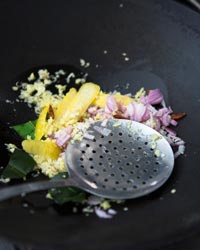Recipe: Thai mussels

Simply sign up to the Life & Arts myFT Digest -- delivered directly to your inbox.
You have to be careful with mussels. I am not talking about the cooking process, which is a relatively simple affair: just as long as you clean them well and take them off the heat as soon as they open, it’s a doddle. The care is in making sure they are spanking fresh – and yet not quite.
Some years ago we found ourselves toddling around some rock pools in Donegal on a balmy August afternoon. Not only did we have the whole sandy beach to ourselves but the low tide had also exposed huge colonies of fat mussels on almost every rock. We were, sad to relate, ridiculously greedy and brought back buckets of the glistening bivalves for our supper. With a glad hand we rinsed and bearded the mussels and then stewed them with a little onion, white wine and parsley. They were hugely plump, looked incredibly appetising and were massively disappointing. Much as I like salt, these mussels tasted purely of the water from which they had so recently been plucked and therefore proved completely inedible.
Mussels need purging in fresh water. I know that now. The fact is, unless you harvest them yourself, they will come to you ready purged. It is always a good idea to give them a rinse but there is very little chance that you will ever buy mussels that are too fresh. Quite the opposite. Mussels are extremely perishable and are, unfortunately, a great deal more likely to be sold too old rather than too young. Happily, it is not difficult to judge whether they are past it: one good whiff will tell the tale, and if they do not smell sweet and saline they should be rejected.
We perhaps associate – well, I do, or used to – mussels with the Atlantic. I have enjoyed many a pot of moules frites in Normandy; Belgium is renowned for its mussels, and they are plentiful all around the British Isles. However, I don’t know why but in southern Calabria a fortnight ago I was mildly surprised to see them in abundance. We had them on the half-shell baked with breadcrumbs (€3, thank you very much), cooked pretty much like moules marinières as an antipasto and in a huge dish of tagliolini with prawns, octopus and other bits of seafood in a tomato sauce. On each occasion they were sweet and succulent.
As soon as I got home, I bought a bag and, perversely, cooked them a different way altogether, even further from the Atlantic.
Rowley Leigh is the chef at Le Café Anglais
——————————————-
Thai mussels
Ingredients
A good and inexpensive family meal. A more sophisticated presentation is possible by shucking the mussels after they are cooked and then reheating them (very, very gently) in the liquor. Serves four as a main course.

2kg mussels
1 shallot
2 cloves garlic
1 rhizome root ginger
1 stick lemongrass
1 green chilli
3 lime leaves
100g basmati rice
2 tbs sunflower or similar neutral cooking oil
2 tsp fish sauce
75ml dry white wine
100ml coconut milk
1 bunch coriander
• Rinse the mussels in plenty of cold running water before scraping them clean and removing their beards. Rinse them again and hold in reserve. Peel and finely chop the shallot, garlic and ginger (enough to produce a tablespoon). Cut the lemongrass into the finest possible slices. Split the chilli, remove the seeds and chop finely. Cut the lime leaves into very fine shreds.

• Rinse the rice in several changes of cold water. Bring a pot of well-salted water to the boil, add the rice and cook for nine minutes. Drain the rice and keep warm. While the rice is cooking, heat the oil in a large saucepan, casserole or wok and fry all the chopped aromatics for a couple of minutes before adding the mussels. Turn the mussels in the mixture before adding the fish sauce and white wine, then seal the pot with a well-fitting lid. Shake the pan a couple of times and check that the mussels are done after a few minutes.
• As soon as the mussels are done, tip them and their liquid into a colander suspended over a large bowl. Strain the liquid back into the casserole and reduce at a fast boil for a minute or two. Pour in the coconut milk and whisk well to amalgamate. Coarsely chop the coriander and add to the sauce. Divide the rice between four bowls and pile the mussels on top. Pour the aromatic broth over the mussels.
——————————————-
Rowley’s drinking choice
A zippy Sauvignon Blanc would work well with mussels but my personal preference is for a not-overweight Riesling: a traditional Kabinett with a little residual sugar would be sensational.
Comments